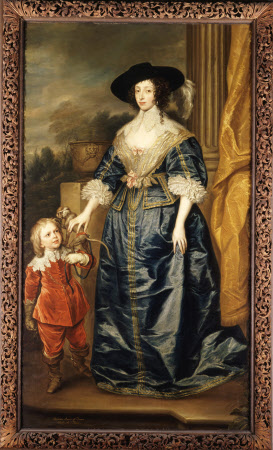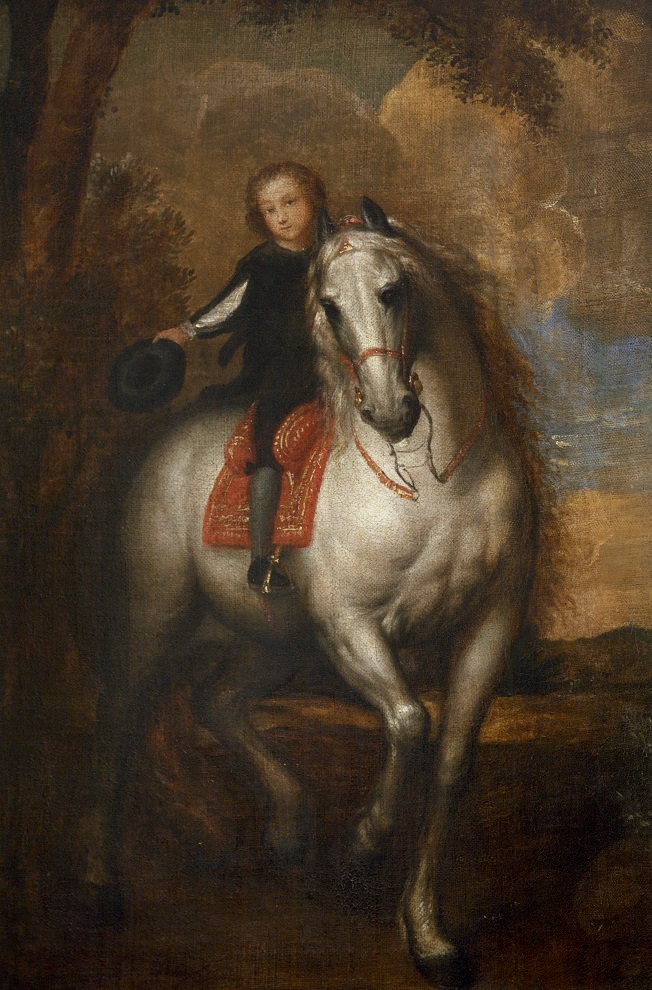
Sir Jeffrey Hudson (1619-1682) was born in Oakham in Rutland. His place in the historical record was secured when Queen Henrietta Maria (1609-1669), the wife of King Charles I, took him into her service as a court performer after he, reportedly, leapt from a pie at a dinner given by the Duchess of Buckingham.
Although this striking 17th century painting by Charles Jervas (after Van Dyck) features both members of the royal household it is clear – at a glance – whose portrait this is. Here Sir Jeffrey Hudson – a royal favourite with increasing independence and agency and friend to Queen Henrietta Maria – appears not as a person in their own right but rather as a prop or possession, a symbol intended primarily to show the Queen’s love of dance, music and theatre.
Queen Henrietta Maria (1609-1669) and Sir Jeffrey Hudson (1619-1682) (after Van Dyck) by Charles Jervas (Dublin 1675 – London 1739) about 1700-39. ©National Trust Images/Derrick E. Witty
If we shift our attention to Jeffrey and dig a little deeper, we find a rich and full life and a fascinating story of adventures beyond the Royal court. Documents from the period point to Jeffrey undertaking a mission to France on behalf of the Queen, being captured and released by pirates, and duelling on horseback. Towards the end of his life we know that Jeffrey was imprisoned for supposed complicity in the ‘Popish Plot’ but was subsequently released in 1679.
Recent scholarship has also drawn attention to Sir Jeffrey’s absence in performance history, despite his widespread fame and presence in numerous published texts of the day. Thomas Postlewait (2015) states: ‘The fundamental issue is not Hudson’s invisibility, but the specific nature of his visibility… We have turned away from him because we can see and identify him without difficulty. But what we see has been determined by how we see, and that how reveals a striking case of willful avoidance or dismissal… He fits, all too neatly, within the confining – and often dismissive – category of “the Queen’s Dwarf”’.

Sir Jeffrey Hudson (1619-1682) on Horseback, after Sir Anthony Van Dyck (Antwerp 1599 – London 1641). ©National Trust Image
Alternative reading
We invited people with lived experience of disability to offer their own personal reflections on some of the stories in Everywhere and Nowhere. Artist Christopher Samuel offers an alternative reading of Sir Jeffrey Hudson’s story.
I love the story of Sir Jeffrey Hudson – over time he went from having no autonomy over his life, to being seen as an individual with a rich life, full of adventures. His story resonated with me personally as someone who has had to fight to be recognised as a person with limitless potential myself.
Throughout history, disability histories have been underrepresented or absent. It is important that disabled people can see themselves represented in history, or it implies that we do not matter. Stories like Sir Jeffrey Hudson’s allow us to start a conversation about how we see stories about disability, and whose lens we see them through.
I am immediately reminded of how difficult it can be for some disabled people to have autonomy and agency over their own lives, even today. The reality of the barriers that still exist – in financial support, managing your care needs, housing, work – can all limit the life choices that some disabled people can make. Stories like Sir Jeffrey Hudson’s are fantastic for starting conversations around disability, autonomy, and disabled people’s place in society and history.
Reference:
Postlewait, T. (2015) ‘Notorious Jeffrey Hudson: The ‘Court Wonder’ of the Caroline Masques (1626-1640), in Nadine George-Graves (ed) The Oxford Handbook of Dance and Theater. Oxford: Oxford University Press